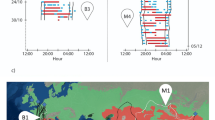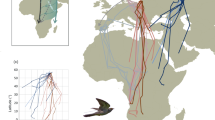Abstract
Most migratory species migrate at night, and the benefits associated with nocturnal migration have been well reviewed; however, less attention has been paid to the benefits associated with diurnal migration. There are two theories for diurnal migration: (1) diurnal migration allows for the use of thermals and therefore reduces energy loss, and (2) the fly-and-forage hypothesis, which suggests that diurnal migrants can search for prey and forage as they migrate. We investigated whether American crows (Corvus brachyrhynchos) engage in the fly-and-forage strategy of diurnal migration as they migrated north in the spring. We tracked eight radio-tagged crows as they migrated hundreds of kilometers in the spring to determine if they were diurnal migrants, whether they migrated with conspecifics, whether they stopped to forage, and if they did stop, whether they forage with conspecifics. All crows migrated during the day, and while on several occasions crows were seen migrating in close association with conspecifics, all crows were also observed migrating alone. On average, crows migrated approximately 300 km the day they left their wintering grounds, and over the course of this day, they stopped twice and foraged at these locations for 35 min. On all but one occasion, the stops made during migration were to forage with groups of conspecifics. While the fly-and-forage hypothesis for diurnal migration has primary been applied to raptors, many diurnal migrants forage socially, and the presence of foraging conspecifics and/or heterospecifics may be a significant benefit in locating food resources and ultimately migrating during the day.



Similar content being viewed by others
References
Alerstam T (2009) Fly by night or day? Optimal daily timing of bird migration. J Theoretical Biol 258:530–536
Berthold P, Helbig AJ, Mohr G, Querner U (1992) Rapid microevolution of migratory behavior in a wild bird species. Nature 360:668–670
Black CT (1941) Ecological and economic relations of the crow, with special reference to Illinois. PhD thesis. University of Illinois, Urbana–Champaign
Boarman WI, Heinrich B (1999) Common raven (Corvus corax), the birds of North America online (A. Poole, Ed.). Cornell Lab of Ornithology, Ithaca, New York
Cochran WW, Lord RD (1963) A radio tracking system for wild animals. J Wildl Manage 27:9–24
Emlen JT Jr (1938) Midwinter distribution of the American crow in New York State. Ecology 19:264–275
Fujita G, Higucki H (2005) Gregarious foraging in barn swallows after the breeding season. J Ethol 23:139–146
Gill RE Jr, Tibbitts TL, Douglas DC, Handel CM, Mulchay DM, Gottschalck JC, Warnock N, McCaffery BJ, Battley PF, Piersma T (2009) Extreme endurance flights by landbirds crossing the Pacific Ocean: ecological corridor rather than barrier? Proc R Soc Lond B Biol 276:447–457
Good EE (1952) The life history of the American crow Corvus brachyrhynchos. PhD Thesis. Ohio State University, Columbus
Graber JW, Graber RR, Kirk EL (1987) Illinois birds: Corvidae. Ill Nat Hist Surv Biol Notes 126:17–34
Heinrich B (1988) Winter foraging at carcasses by three sympatirc corvids, with emphasis on recruitment by the raven, Corvus corax. Behav Ecol Sociobiol 23:141–156
Henderson IG, Hart PJB (1991) Age-specific differences in the winter foraging strategies of Rooks Corvus frugilegus. Oecologia 85:492–497
Kalmbach NS, Aldous SE (1940) Winter banding of Oklahoma crows. Wilson Bull 52:198–206
Kerlinger P (1989) Flight strategies of migrating hawks. University of Chicago Press, Chicago
Kerlinger P, Moore FR (1989) Atmospheric structure and avian migration. In: Power DM (ed) Current Ornithology, 6. Plenum Press, New York
Klaassen RHG, Strandberg R, Hake M, Alerstam T (2008) Flexibility in daily travel routines causes regional variation in bird migration speed. Behav Ecol Sociobiol 62:1427–1432
Knight RL, Anderson DP (1990) Effects of supplemental feeding on an avian scavenging guild. Wildl Soc Bull 18:388–394
Lank DB (1989) Why fly by night—inferences from tidally induced migratory departures of sandpipers. J Field Ornithology 60:154–161
Marzluff JM, Heinrich B, Marzluff CS (1996) Raven roosts are mobile information centres. Anim Behav 51:89–103
McGowan A, Sharp SP, Simeoni M, Hatchwell BJ (2006) Competing for position in the communal roosts of long-tailed tits. Anim Behav 72:1035–1043
Mcmahon BF, Evans RM (1992) Foraging strategies of American white pelicans. Behaviour 120:69–89
Pöysä H, Elmberg J, Sjöberg, Nummi P (1998) Habitat selection rules in breeding Mallards (Anas platyrhynchos): a test of two competing hypotheses. Oecologia 114:283–287
Prior KA, Weatherhead PJ (1991) Competition at the carcass—opportunities for social foraging by turkey vultures in southern Ontario. Canadian J Zoo 69:1550–1556
Sparling DW, Krapu GL (1994) Communal roosting and foraging behavior of staging Sandhill Cranes. Wilson Bull 106:62–77
Strandberg R, Alerstam T (2007) The strategy of fly-and-forage migration, illustrated for the osprey (Pandion haliaetus). Behav Ecol Sociobiol 61:1865–1875
Strandberg R, Klaasen RHG, Hake M, Olofsson P, Thorup K, Alerstam T (2008) Complex timing of Marsh Harrier Circus aeruginosus migration due to pre- and post-migratory movements. Ardea 96:159–171
Stutchbury BJM, Tarof SA, Done T, Gow E, Kramer PM, Tautin J, Fox JW, Afanasyev V (2009) Tracking long-distance songbird migration by using geolocators. Science 323:896
Thomson RL, Forsman JT, Monkkonen M (2003) Positive interactions between migrant and resident birds: testing the heterospecific attraction hypothesis. Oecologia 134:431–438
Verbeek NA, Caffery C (2002) American Crow (Corvus brachyrhynchos). The Birds of North America Online (A. Poole Ed.) Cornell Lab of Ornithology, Ithaca, New York.
Ward P, Zahavi A (1973) The importance of certain assemblages of birds as ‘information centres’ for food finding. Ibis 117:517–534
Acknowledgments
We thank T. Beveroth, C. LaPoint, M. Alessi, W. Cochran, D. Enstrom, and J. Deppe for their assistance. American Crows were radio-tagged under the University of Illinois, Urbana–Champaign IACUC protocol no. 04010.
Author information
Authors and Affiliations
Corresponding author
Additional information
Communicated by W. Wiltschko
Rights and permissions
About this article
Cite this article
Ward, M.P., Raim, A. The fly-and-social foraging hypothesis for diurnal migration: why American crows migrate during the day. Behav Ecol Sociobiol 65, 1411–1418 (2011). https://doi.org/10.1007/s00265-011-1151-0
Received:
Revised:
Accepted:
Published:
Issue Date:
DOI: https://doi.org/10.1007/s00265-011-1151-0




